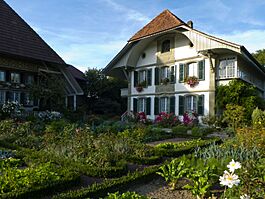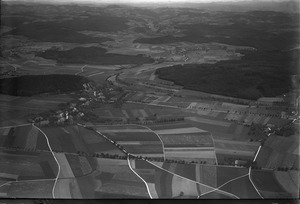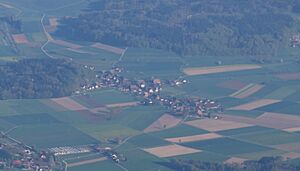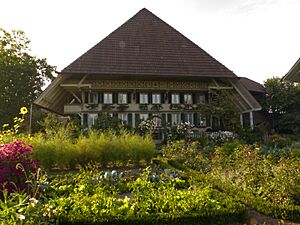Niederösch facts for kids
Quick facts for kids
Niederösch
|
||
|---|---|---|

Stöckli house in Niederösch village
|
||
|
||
| Country | Switzerland | |
| Canton | Bern | |
| District | Emmental | |
| Area | ||
| • Total | 4.6 km2 (1.8 sq mi) | |
| Elevation | 485 m (1,591 ft) | |
| Population
(Dec 2014)
|
||
| • Total | 237 | |
| • Density | 51.5/km2 (133.4/sq mi) | |
| Postal code |
3424
|
|
| Surrounded by | Alchenstorf, Koppigen, Oberösch, Rumendingen, Utzenstorf | |
Niederösch was once a small town, or municipality, in Switzerland. It was located in the Emmental area of the Bern canton. On January 1, 2016, Niederösch joined with another nearby town, Oberösch, to become part of Ersigen.
Contents
History of Niederösch
Niederösch was first mentioned in old writings in the year 886. Back then, it was called Osse. Later, in 1310, it was known as villa Öschge inferioris. The town was originally part of a larger village called Ösch. Over time, Ösch split into two separate parts: Niederösch and Oberösch.
The oldest sign of people living in this area is a grave from the late Bronze Age. This was a time long ago when people used bronze tools. In 886, a religious group called the Abbey of St. Gall owned land in both Niederösch and Oberösch. This land was later given to another abbey in France in 994.
During the 1200s and 1300s, powerful families like the Kyburg counts also owned land here. They would give this land to their loyal followers, called vassals. In 1320, a Kyburg vassal named Albrecht of Thorberg sold some land in Niederösch. However, he kept control of the local forest and a low court, which handled minor legal matters.
Later, the forest and court were sold to the Lords of Rohrmoos. In 1423, a woman from the Rohrmoos family sold them to the city of Burgdorf. Burgdorf then combined the courts of several towns, including Niederösch, under one main court. Niederösch has always been part of the parish (a church district) of Kirchberg. In 1803, it became part of the Burgdorf district.
Geography and Landscape
Niederösch covers an area of about 4.63 square kilometers (about 1.79 square miles). Most of this land, about 68.3%, is used for farming. This means people grow crops or keep animals there. Another large part, 26.6%, is covered by forests. The remaining 5.0% of the land has buildings or roads on it.
Most of the buildings are homes, making up 3.0% of the land. Roads and other transport areas make up 1.7%. All the forested land is covered with thick forests. For farming, 54.6% of the land is used for growing crops, and 12.7% is used for pastures where animals graze.
Niederösch is known as a Straßendorf. This means the village stretches out mostly along a single road. It has an Upper Village (Oberdorf) and a Lower Village (Unterdorf) along the Ösch river. There is also a farm called Rychebrunne.
In 2010, Niederösch became part of the new Emmental administrative district.
Coat of Arms
The blazon (a special description) of Niederösch's coat of arms is: Azure an Ash Tree Or issuant from a Mount of 3 Coupeaux Vert. This means it shows a gold ash tree growing from three green hills on a blue background. The ash tree (called Esche in German) is important because it sounds like "Ösch," which is part of the town's name. This is called canting arms, where the symbol on the coat of arms hints at the name.
Population and People
In 2014, Niederösch had a population of 237 people. In 2010, about 1.7% of the people living there were foreign nationals. Over the ten years from 2000 to 2010, the population grew by 16.3%. This growth was mostly due to people moving into the town.
Most people in Niederösch (97.1%) speak German as their main language. A small number speak French (1.4%) or Italian (1.0%).
In 2008, the population was made up of 47.3% men and 52.7% women. Most of the people were Swiss citizens. About 39.5% of the people living in Niederösch in 2000 were also born there.
In 2010, about 25.3% of the population were children and teenagers (0–19 years old). Adults (20–64 years old) made up 60.6%, and seniors (over 64 years old) made up 14.1%.
The chart below shows how the population of Niederösch has changed over many years:

Important Heritage Sites
The Gehöft house, located at Unterdorf 9, 10, is a very important building. It is listed as a Swiss heritage site of national significance. This means it is a special place that helps tell the story of Switzerland. The entire village of Niederösch is also part of the Inventory of Swiss Heritage Sites. This inventory lists places that are important for Swiss history and culture.
Economy and Jobs
In 2011, Niederösch had a very low unemployment rate, meaning almost everyone who wanted a job had one. In 2008, there were 73 people working in the town.
- Most people (50) worked in the primary economic sector. This means they worked in farming or other jobs that get raw materials from nature. There were 17 businesses in this area.
- A few people (4) worked in the secondary sector. This includes jobs like manufacturing (making things) or construction (building things). There were 3 businesses in this area.
- Some people (19) worked in the tertiary sector. These are service jobs, like working in shops or restaurants. There were 3 businesses in this area.
In 2008, there were 49 full-time jobs in Niederösch. Most of these were in agriculture. Other jobs were in manufacturing, construction, sales, and hospitality (hotels or restaurants).
In 2000, 12 workers came into Niederösch for their jobs, while 58 workers left the town to work somewhere else. This means more people left Niederösch for work than came in. About 9.3% of working people used public transportation to get to work, and 40.7% used a private car.
Religion
Based on the 2000 census, most people in Niederösch (86.7%) belonged to the Swiss Reformed Church, which is a Protestant church. A smaller number (4.8%) were Roman Catholic. There were also a few people who belonged to other Christian churches. About 3.81% of the population did not belong to any church.
Education
In Niederösch, about 42.9% of the people had finished upper secondary education. This is like high school. About 13.3% had gone on to higher education, like a university or a specialized college.
The school system in the Canton of Bern starts with one year of optional Kindergarten. After that, students go to six years of Primary school. Then, they have three years of lower Secondary school. In secondary school, students are grouped based on their abilities. After lower Secondary, students can continue their schooling or start an apprenticeship, where they learn a trade while working.
During the 2010-2011 school year, 32 students attended classes in Niederösch. There was one kindergarten class with 12 students and one primary class with 20 students.
In 2000, 4 students came to Niederösch from other towns to go to school. At the same time, 12 students from Niederösch went to schools outside the town.
See also
 In Spanish: Niederösch para niños
In Spanish: Niederösch para niños







